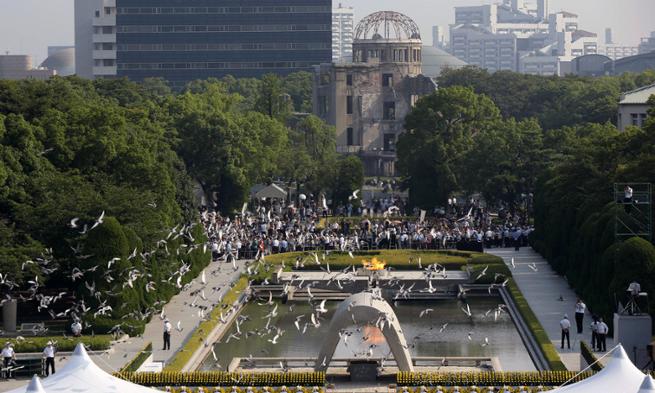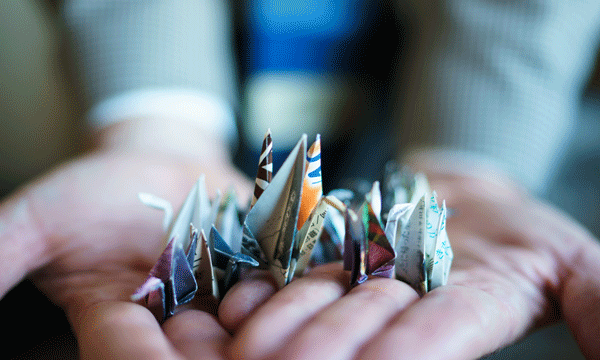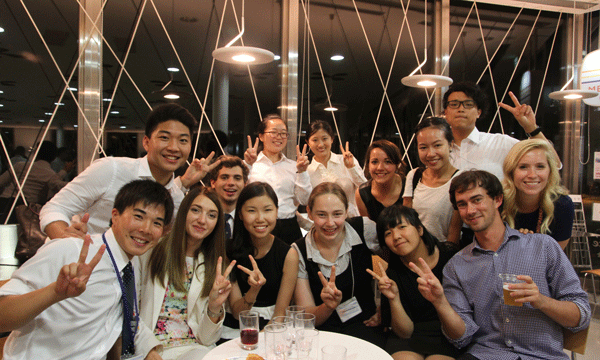The promise of peace
Nation and World
By Andy Perrine (’86)
Madison's executive editor joins students from around the globe in Hiroshima for 70th anniversary of bombing
From Winter 2016 Madison.
Arriving in Hiroshima
As our cab makes its way through a record-setting heat wave gripping Japan, the driver asks, “Do you like the bizz-bizz-bizz?” My daughter Alice and I look at each other wondering what he means. Looking at us in the rearview, he can see we don’t understand, and adds, “Chickadas! You know, chickadas!” Still, we are bewildered. He then holds up his finger and thumb about three inches apart and says, “Bizz-bizz-bizz! Chickadas!” Suddenly, with delighted recognition, we respond, “Oh! Cicadas!” “Yes, yes, yes,” he replies. I say, “We have cicadas in America, but they are not as loud as the ones you have here in Japan.” He says, “I like chickadas because they remind me of summer.”
We had arrived in Hiroshima traveling from Tokyo and Osaka on bullet trains through a hot haze obscuring the landscape. During the last leg of our journey, I read in the Japan Times that at least 60 Japanese were dead because of this heat wave.
Despite such oppressive weather, and with the cicadas buzzing loudly, the citizens of Hiroshima are preparing for the 70th anniversary of when the first atomic bomb burst 2,000 feet above the heads of their parents and grandparents. Held on Aug. 6 every year since 1947, the Hiroshima Peace Memorial Ceremony draws tens of thousands from around the globe to hear speeches and the ringing of the Peace Bell at 8:15 a.m., exactly when the bomb exploded in mid-air on Aug. 6, 1945.
INU Global Citizenship and Peace Conference
I am in attendance because students from universities on nearly every continent — including ones from Madison — travel to Hiroshima for a conference held by the International Network of Universities, of which JMU is a founding member and current president. The INU Global Citizenship and Peace Conference, now in its 10th year, begins annually with students attending the Aug. 6 Peace Memorial Ceremony at Ground Zero in Hiroshima. I’d been told that beginning the conference at this solemn event creates a powerful impact on the students’ experience. What I didn’t anticipate is how surprising the experience would be for me, too.

“Hiroshima is the international symbol of the horror of war and the triumph of post-war reconstruction,” says John Scherpereel, JMU political science professor and one of the conference organizers. “We want our students to think about the conditions of peace and to think about the opposite of peace. There is no better place in the world to grapple with such important issues than Hiroshima.”
The ceremony
This year the outdoor ceremony is on a Thursday. Recorded public address announcements alternating between Japanese and English remind everyone at the Peace Memorial Park to keep hydrated. Attendees searching for seats turn their faces up toward mist machines as they seek relief from the torrid heat. Using complementary cardboard fans emblazoned with bullet train advertisements, they rapidly fan themselves. It is only 7:30 in the morning.
As the ceremony begins and the crowd settles in, the throbbing buzz of cicadas grows from background noise to become almost a distraction. Among several speakers, Japanese Prime Minister Shinzo Abe delivers remarks and sits back down beside Caroline Kennedy, American ambassador to Japan. The crowd suddenly quiets and grows somber as two children prepare to ring the large Peace Bell. All heads bow at the first low sonorous toll.
Our sun is 92 million miles from Earth. Yet on this sweltering August day, it is hot enough to literally burn our skin. And with the large bell reverberating loudly over and over, standing at Ground Zero exactly 70 years to the moment after the bomb utterly changed our world, it is shockingly vivid to imagine the horror of another searing sun bursting unexpectedly overhead, vaporizing us all.
'We want our students to think about the conditions of peace and to think about the opposite of peace.’ — John Scherpereel, political science professor
Finding inspiration
“It was really emotional,” says Rodrigo Souza, a native Brazilian studying at Malmo University in Sweden who had traveled to Hiroshima on a Portuguese passport. “How could we do that to each other? The amount of destruction?” Souza trails off searching for composure. “But at the same time,” he says, recovering, “I saw the positive in how much we have improved. Being in Hiroshima and seeing in the museum all the detailed horrors of that war — as much as I was sad for what happened, I was happy inside to know how much we improved.” Souza reflects and smiles, “And people from all over the world were there.”
His hopeful perspective is not unusual for the students attending the conference. In fact, even while reflecting on the horrifying effects of the atomic bomb explosion, most of the students express optimism. Maybe it is the gracefulness with which the Japanese moved from devastation to working toward reconciliation that inspired them.
Hajime Nishitani, vice president of Hiroshima University, an INU member and a founder of the conference, says, “We could have started the conference with studying topics and then going to the ceremony. But at Hiroshima and at the INU, we believe we should begin with the feelings and sentiments and real emotions. And then, of course, as students and scholars, we move to the academic side. But we shouldn’t forget what happened here. It’s not an abstract thing.”
Among the 80 conference attendees are four JMU students. At the opening reception held the evening before the ceremony at Ground Zero, students and faculty from INU universities around the world met for the first time in a big room at Hiroshima University. They discovered by particular markings on their name badges which country groups they were assigned to for a simulation of international negotiations during the conference. The reception began somewhat stiffly, with participants finding their fellow group members and struggling to identify a common language. But the spirit among the students was strong. And after stumbling over name pronunciations and botched handshakes, exuberance in the room grew to almost giddy levels.
'Mutual understanding is critical to working toward peace.’ — Hajime Nishitani, vice president, Hiroshima University
With deliberate irony, JMU senior Megan Hinton says, “In talking with my peers from across the world, I come to find out that not everyone thinks the way I do.” Becoming serious, she adds. “It was interesting to see how perspectives varied across cultures, and I value that.”
Jubril Abdullahi, one of Hinton’s peers studying at European University Viadrina in Germany, agrees. The native German citizen of African descent, who speaks fluent English, says, “The heart of the program is bringing people from all over the world with different points of views together to have them discuss their ideas and actually to become friends, of course, for many years to come, hopefully.”
.
“That’s the notion behind the whole conference,” says Scherpereel in assent. “The thinking behind the conference stems from the recognition that international peace is built through concrete partnerships and concrete friendships.” Nishitani adds, “We thought deeply about the construction of the seminars as a way to forge a bond between students. They have to collaborate together. They have to study together and eat dinner together. We’ve seen in many cases that these relationships last many years. Such mutual understanding is critical to working toward peace.”
And while experiencing how other cultures around the world see things quite differently can enlighten, realizing that we also share human similarities with people who speak, look and live nothing like we do also can edify. Like our cabbie, the sound of cicadas reminds me of summertime, too.
